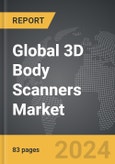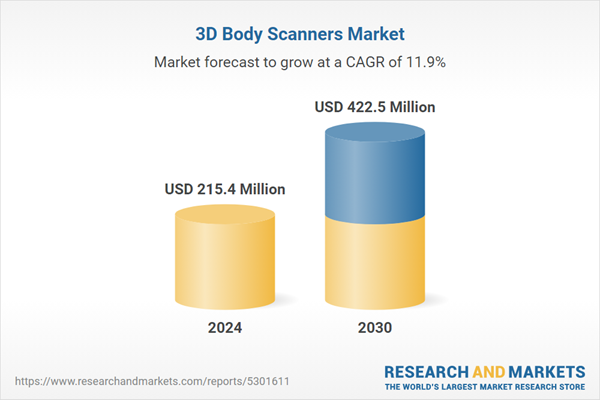The global market for 3D Body Scanners was valued at USD 215.4 Million in 2024 and is projected to reach USD 422.5 Million by 2030, growing at a CAGR of 11.9% from 2024 to 2030. This comprehensive report provides an in-depth analysis of market trends, drivers, and forecasts, helping you make informed business decisions.
Global 3D Body Scanners Market - Key Trends and Drivers Summarized
Why Are 3D Body Scanners Revolutionizing Multiple Industries?
3D body scanners are rapidly transforming a variety of sectors by offering precise, comprehensive body measurements and data, enabling new applications in healthcare, fashion, fitness, and security. These advanced scanning systems use technologies such as laser, infrared, and structured light to capture the detailed contours and dimensions of the human body in just a few seconds. Unlike traditional measuring methods, which can be time-consuming and prone to human error, 3D body scanners provide highly accurate, full-body measurements with unprecedented speed and consistency. As a result, industries are adopting this technology to streamline operations, enhance user experiences, and deliver more personalized services. Whether it's a tailor using a 3D scan to create custom clothing or a healthcare professional analyzing a patient's body composition, 3D body scanners are revolutionizing the way businesses and services interact with human anatomy. These scanners are increasingly found in retail stores, gyms, medical offices, and even airports, signaling a shift toward data-driven solutions that emphasize precision and efficiency in meeting the growing demand for individualized products and services.How Are 3D Body Scanners Shaping the Future of Fashion and Retail?
In the fashion and retail sectors, 3D body scanning technology is creating a more personalized and customer-centric experience. Traditionally, finding the perfect fit for clothing has been a challenge for consumers and retailers, often leading to high return rates and dissatisfied customers. 3D body scanners are addressing this issue by allowing retailers to offer customized apparel based on each customer's unique body shape and measurements. Some companies are already utilizing this technology to create made-to-measure clothing, eliminating the need for standardized sizing systems that often fail to accommodate different body types. Customers can now enter a store, have their body scanned in minutes, and receive garments tailored specifically to their body dimensions. Beyond physical stores, e-commerce platforms are also integrating 3D scanning to offer virtual fitting rooms where customers can visualize how clothing will fit before making a purchase. This significantly reduces the uncertainty associated with online shopping, enhancing customer satisfaction and minimizing returns. In addition to custom clothing, the data from these scanners is also being used to improve garment design and production efficiency, enabling brands to optimize fabric usage and reduce waste. The ability to offer highly personalized and sustainable fashion solutions is giving retailers a competitive edge in a market where customization and sustainability are increasingly important to consumers.What Role Do 3D Body Scanners Play in Healthcare and Fitness?
In the healthcare and fitness industries, 3D body scanners are proving to be invaluable tools for assessing and monitoring an individual's physical condition with remarkable accuracy. In healthcare, these scanners provide detailed body composition data, such as fat distribution, muscle mass, and posture analysis, which is essential for diagnosing conditions, planning treatments, and tracking patient progress. This level of detail can help physicians and healthcare professionals detect early signs of health issues such as obesity, diabetes, and musculoskeletal disorders. In rehabilitation, 3D body scanners are used to evaluate the effectiveness of physical therapy, enabling therapists to adjust treatment plans based on real-time data about a patient's recovery progress. Similarly, in the fitness industry, 3D body scanners are revolutionizing how fitness goals are set and tracked. Instead of relying on traditional methods such as scales and measuring tapes, gyms and personal trainers are utilizing these scanners to provide a more comprehensive view of body changes over time. Fitness enthusiasts can receive detailed reports on their body composition, helping them to tailor their exercise and nutrition plans more effectively. The ability to visually track progress not only enhances motivation but also allows for a more scientific approach to achieving fitness goals. Whether it's optimizing athletic performance or providing critical health insights, 3D body scanners are making personalized health and fitness management more accessible and accurate than ever before.What Factors Are Driving the Growth in the 3D Body Scanners Market?
The growth in the 3D body scanners market is driven by several factors, reflecting both advancements in technology and shifting consumer expectations. One of the primary drivers is the increasing demand for personalized experiences across various industries, especially in fashion, healthcare, and fitness. Consumers today expect tailored products and services that cater to their individual needs, and 3D body scanning technology offers the precision and customization that these industries require. In the retail sector, for instance, the ability to provide made-to-measure clothing or virtual fitting rooms is creating new business models that align with consumer desires for personalized shopping experiences, reducing return rates and enhancing brand loyalty. Additionally, advancements in sensor technologies, 3D imaging, and data processing have made body scanners more affordable, accurate, and versatile, allowing for wider adoption in both commercial and professional environments. In healthcare, the rise of preventive care and personalized medicine is driving the need for technologies that offer detailed body composition analysis, making 3D scanners an essential tool for early diagnosis and ongoing health monitoring. The fitness industry's shift toward data-driven approaches, particularly in the growing market for fitness tracking and body composition analysis, is another key growth driver. Moreover, the increasing use of 3D body scanners in security and defense, particularly for full-body scanning in airports and other high-security environments, is boosting demand. These scanners can detect concealed objects with greater accuracy than traditional methods, enhancing security while minimizing the need for invasive body searches. Overall, the convergence of technological innovation, consumer demand for personalization, and the growing importance of data-driven decision-making across industries are propelling the 3D body scanners market forward, making it a critical technology for the future.Report Scope
The report analyzes the 3D Body Scanners market, presented in terms of market value (USD Thousand). The analysis covers the key segments and geographic regions outlined below.Segments
Application (Critical Infrastructure, Transport).Geographic Regions/Countries
World; United States; Canada; Japan; China; Europe (France; Germany; Italy; United Kingdom; Spain; Russia; and Rest of Europe); Asia-Pacific (Australia; India; South Korea; and Rest of Asia-Pacific); Latin America (Argentina; Brazil; Mexico; and Rest of Latin America); Middle East (Iran; Israel; Saudi Arabia; United Arab Emirates; and Rest of Middle East); and Africa.Key Insights:
- Market Growth: Understand the significant growth trajectory of the Critical Infrastructure Application segment, which is expected to reach $243.1 Million by 2030 with a CAGR of a 11.4%. The Transport Application segment is also set to grow at 12.6% CAGR over the analysis period.
- Regional Analysis: Gain insights into the U.S. market, valued at $55.6 Million in 2024, and China, forecasted to grow at an impressive 15.3% CAGR to reach $97.2 Million by 2030. Discover growth trends in other key regions, including Japan, Canada, Germany, and the Asia-Pacific.
Report Features:
- Comprehensive Market Data: Independent analysis of annual sales and market forecasts in USD from 2024 to 2030.
- In-Depth Regional Analysis: Detailed insights into key markets, including the U.S., China, Japan, Canada, Europe, Asia-Pacific, Latin America, Middle East, and Africa.
- Company Profiles: Coverage of major players such as ADANI, Braun & Company Ltd, Brijot Imaging Systems, Inc., C.E.I.A. SpA, Leidos Security Detection & Automation and more.
- Complimentary Updates: Receive free report updates for one year to keep you informed of the latest market developments.
Why You Should Buy This Report:
- Detailed Market Analysis: Access a thorough analysis of the Global 3D Body Scanners Market, covering all major geographic regions and market segments.
- Competitive Insights: Get an overview of the competitive landscape, including the market presence of major players across different geographies.
- Future Trends and Drivers: Understand the key trends and drivers shaping the future of the Global 3D Body Scanners Market.
- Actionable Insights: Benefit from actionable insights that can help you identify new revenue opportunities and make strategic business decisions.
Key Questions Answered:
- How is the Global 3D Body Scanners Market expected to evolve by 2030?
- What are the main drivers and restraints affecting the market?
- Which market segments will grow the most over the forecast period?
- How will market shares for different regions and segments change by 2030?
- Who are the leading players in the market, and what are their prospects?
Some of the 26 major companies featured in this 3D Body Scanners market report include:
- ADANI
- Braun & Company Ltd
- Brijot Imaging Systems, Inc.
- C.E.I.A. SpA
- Leidos Security Detection & Automation
- Millivision Technologies
- Nuctech Co Ltd.
- OD Security
- Rapiscan Systems
- Rohde & Schwarz
- Smiths Detection Group Ltd
- Tek 84 Inc
- Westminster International Ltd
Table of Contents
I. METHODOLOGYII. EXECUTIVE SUMMARY2. FOCUS ON SELECT PLAYERSIII. MARKET ANALYSISIV. COMPETITION
1. MARKET OVERVIEW
3. MARKET TRENDS & DRIVERS
4. GLOBAL MARKET PERSPECTIVE
UNITED STATES
CANADA
JAPAN
CHINA
EUROPE
FRANCE
GERMANY
ITALY
UNITED KINGDOM
SPAIN
RUSSIA
REST OF EUROPE
ASIA-PACIFIC
AUSTRALIA
INDIA
SOUTH KOREA
REST OF ASIA-PACIFIC
LATIN AMERICA
ARGENTINA
BRAZIL
MEXICO
REST OF LATIN AMERICA
MIDDLE EAST
IRAN
ISRAEL
SAUDI ARABIA
UNITED ARAB EMIRATES
REST OF MIDDLE EAST
AFRICA
Companies Mentioned (Partial List)
A selection of companies mentioned in this report includes, but is not limited to:
- ADANI
- Braun & Company Ltd
- Brijot Imaging Systems, Inc.
- C.E.I.A. SpA
- Leidos Security Detection & Automation
- Millivision Technologies
- Nuctech Co Ltd.
- OD Security
- Rapiscan Systems
- Rohde & Schwarz
- Smiths Detection Group Ltd
- Tek 84 Inc
- Westminster International Ltd
Table Information
| Report Attribute | Details |
|---|---|
| No. of Pages | 83 |
| Published | March 2025 |
| Forecast Period | 2024 - 2030 |
| Estimated Market Value ( USD | $ 215.4 Million |
| Forecasted Market Value ( USD | $ 422.5 Million |
| Compound Annual Growth Rate | 11.9% |
| Regions Covered | Global |









